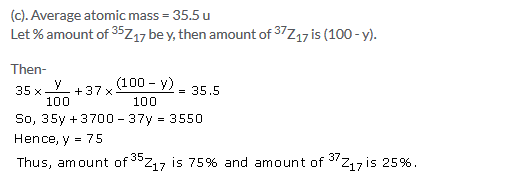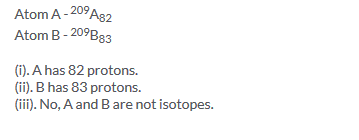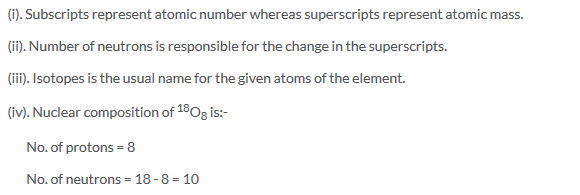Lakhmir Singh Class 9 CBSE Chemistry Text Book PAGE No 191 Answers
Solution 01
Neutron is not present in ordinary hydrogen atom.
Solution 02
J. J. Thomson
Solution 03
Maximum of 2 e- can be accommodated in K shell of an atom.
Solution 04
Maximum of 8 e- can be accommodated in L shell of an atom.
Solution 05
Maximum of 18 e- can be accommodated in M shell of an atom.
Solution 06
Maximum of 32 e- can be accommodated in N shell of an atom.
Solution 07
(a). Maximum of 2 e- can be accommodated in innermost shell of an atom.
(b). Maximum of 8 e- can be accommodated in outermost shell of an atom.
Solution 08
Three subatomic particles present in atom are electrons, protons and neutrons.
Solution 09
Electron is negatively charged particle present in atoms of all the elements.
Solution 10
J. J. Thomson discovered electron.
Solution 11
(a). e-
(b). p+
(c). n
Lakhmir Singh Class 9 CBSE Chemistry Text Book Page No 192 Answers
Solution 12
(a). False
(b). True
(c). False
Solution 13
Nucleus is the central part of an atom in which protons and neutrons are held together.
Solution 14
K, L, M, N were the letters used by Bohr to represent electron shells in an atom.
Solution 15
Protons and neutrons actually determine the mass of atom.
Solution 16
Proton is the positively charged particle present in atoms of all the elements.
Solution 17
Electronic configuration of hydrogen : 1
Solution 18
Proton is 1840 times heavier than electron.
Solution 19
Hydrogen gas produces anode rays consisting of protons in the discharge tube experiment.
Solution 20
Nucleus was discovered by Rutherford in the alpha particle scattering experiment.
Solution 21
Positive charge on the nucleus is due to presence of protons.
Solution 22
(a). 8 electrons are present in outermost shell of Neon.
(b). 7 electrons are present in outermost shell of Chlorine.
Solution 23
(a). L shell can accommodate maximum of 8 e-.
(b). N shell can accommodate maximum of 32 e-.
Solution 24
(a). K shell can accommodate maximum of 2 e-.
(b). M shell can accommodate maximum of 18 e-.
Solution 25
(i). Chadwick discovered ‘neutron’.
(ii). Thomson discovered ‘electron’.
(iii). Goldstein discovered ‘proton’.
Solution 26
(a). Proton has relative charge of +1.
(b). Electron has relative charge of -1.
(c). Neutron has relative charge of 0.
Solution 27
(a) Atomic number
(b) Mass number
(c) 11
(d) 23
(e) 20
(f) Nucleus
(g) Electrons
(h) Protons
(i) 8
(j) 18
(k) Neutron
(l) Negative; Positive; No
Solution 28
Electron is a negatively charged particle found in the atoms of all elements.
The relative mass of an electron is 1/1840 u.
A charge of -1 is carried by an electron.
Solution 29

Solution 30
The deflection of fast moving alpha- particles through small and large angles in Rutherford’s scattering experiment is the evidence for the presence of nucleus in an atom.
Solution 31
Important information furnished about nucleus in Rutherford’s alpha- particle scattering experiment is:
(i). Nucleus of an atom is positively charged.
(ii). Nucleus of an atom is very hard and dense.
(iii). Nucleus of an atom is very small as compared to the size of an atom as a whole.
Solution 32
Most of the alpha- particles passed straight through the gold foil without any deflection in Rutherford’s alpha- particle scattering experiment, this shows that most of the space in an atom is empty.
Solution 33
There are equal no. of positive and negative particles in an atom, so it is neutral as a whole.
Solution 34
(a). Proton is present in same fixed no. in the atoms of any particular element.
(b). Atomic no. is characteristic for any particular element.
Lakhmir Singh Class 9 CBSE Chemistry Text Book Page No 193 Answers
Solution 35
Protons are positively charged particle found in the atoms of all the elements.
Relative mass of proton is 1u.
Relative charge of proton is +1 C.
Solution 36

Solution 37
Difference between proton and neutron-
(1). Proton is positively charged while electron is negatively charged.
(2). Proton is much heavier than electron.
Solution 38
Two observations which shows that atom is not indivisible are-
(1). In J. J. Thomson’s experiment, the stream of cathode rays in the gas discharge tube shows the presence of negatively charged subatomic particles called electrons.
(2). In Goldstein’s experiment, the faint red glow in the gas discharge tube shows the presence of positively charged subatomic particles called protons.
Solution 39
(i). Formation of cathode rays tells about the presence of negatively charged electrons in all the atoms.
(ii). Formation of anode rays tells about the presence of positively charged protons in all the atoms.
Solution 40
The arrangement of electrons in various shells of an atom of the element is known as electronic configuration of the element.
Electronic configuration of oxygen (atomic no. = 8) is (2,6)
Solution 41
Electronic configuration of element with atomic no. 12- (2,8,2)
So, K-2 ; L-8 ; M-2
Solution 42
(a). Nucleus is a small positively charged part at the center of an atom. Nucleus is positively charged.
(b). Rutherford discovered nucleus of an atom.
Solution 43
Alpha – particles were used by Rutherford in his experiment on the discovery of nucleus.
Alpha – particles have +2 units of charge.
Solution 44
(a). There are 13 e- in each atom of the element.
(b). Electronic configuration of given element- (2,8,3)
K-2 ; L-8 ; M-3
Solution 45
Atomic No. – 18
Electronic configuration – (2,8,8)
The special thing about the outermost shell is that it is completely filled with the electrons.
Solution 46
The neutron is a neutral particle found in the nucleus of an atom. Its relative mass is 1 u. It has no charge.
Solution 47
Electron has relative mass of 1/1840 u, proton has 1u and neutron also has 1u.
Electron has relative charge of -1u, proton has +1u and neutron has 0 relative charge.
Solution 48
Protons are positively charged particle found in the atoms of all the elements whereas neutron is a neutral particle found in the nucleus of an atom.
Solution 49
Electron has relative mass of 1/1840 u and proton has relative mass of 1u.
Electron has relative charge of -1u while proton has +1u of relative charge.
Solution 50
Proton has relative mass of 1u and neutron also has relative mass of 1u.
Proton has relative charge of +1u and neutron has no relative charge.
Solution 51
Electron has relative charge of -1 u whereas neutron has no relative charge.
Also, electron has relative mass of 1/1840 u and neutron has relative mass of 1 u.
Solution 52
Protons and neutrons are collectively present in the nucleus at the center while electrons revolve rapidly round the nucleus in fixed circular orbits called energy levels.
Solution 53

Solution 54

Solution 55
(a). The stream of particles coming out from cathode (negative electrode) are called cathode rays. Cathode rays are negatively charged.
(b). When electricity at high voltage is passed through a gas at very low pressure taken in discharge tube, stream of minute particles are given out by the cathode. These stream of particles are called cathode rays.
(c). The conclusion is that all the atoms contain negatively charged particles called electrons.
Solution 56
(a). According to Thomson model of atom- An atom consists of a sphere of positive charge with negatively charged electrons embedded in it. The positive and negative charges in an atom are equal in magnitude.
Neutron was not present in the Thomson model of atom.
(b). When mass no. is 18 and no. of electrons is 7 then
(i). No. of protons = 7
(ii). No. of neutrons = 18 – 7 = 11
(iii). Atomic no. = 7
Solution 57
(a).Rutherford’s model of atom-
1. An atom consists of positively charged, dense and very small nucleus containing all the protons and neutrons. Almost all the mass of atom is concentrated in the nucleus.
2. The nucleus is surrounded by negatively charged electrons. The electrons are revolving at very high speed round the nucleus in fixed circular orbits.
3. The electrostatic attraction between the positively charged nucleus and negatively charged electrons keep the atom held together.
4. An atom is electrically neutral.
5. Most of the space in an atom is empty.
The major drawback of Rutherford model of atom is that it does not explain the stability of the atom.
(b).Given: Mass no. = 23
No. of electrons = 11
Then, no. of protons = 11
No. of neutrons = 23 – 11 = 12
Atomic no. = 11
Solution 58
(a). Bohr’s model of atom-
1. An atom is made up of three particles, namely electrons, protons and neutrons.
2.The protons and neutrons are located in the small nucleus at the center of atom.
3. Electrons revolve round the nucleus in fixed circular orbits.
4. Maximum no. of electrons for any given shell is fixed. Any shell cannot exceed that maximum value.
5. Each given shell is associated with fixed amount of energy.
6. There is no change in energy of electrons as long as they keep revolving in the same energy level, and the atom remains stable.
(b).Given: Atomic no. = 11
Mass no. = 23
Then, electronic configuration – (2,8,1)
Nuclear composition is – 11 protons and 12 neutrons
Lakhmir Singh Class 9 CBSE Chemistry Text Book Page No 194 Answers
Solution 59
(a). (i). Atomic no. is the number of protons in one atom of an element.
(ii). Mass no. is the total number of protons and neutrons present in one atom of the element.
Example- The total no. of protons in a carbon atom is 6, so its atomic no. is 6.
Also, one atom of Na contains 11 protons and 12 neutrons, so its mass no. is 23.
(b). Mass No. = Atomic no. + No. of neutrons
(c). No. of neutrons = Mass No. – Atomic no.
= 24 – 12 = 12
Solution 71
(i). Mass no. = 31
(ii). Atomic no. = 15
(iii). E.C. = (2,8,5)
Solution 72
(a). E.C. – (2,8,7)
(b). Atomic No. = 17
(c). Non-metal
(d). Anion; X-
(e). X must be Chlorine
Solution 73
(a). Atomic no. = 3
(b). Mass no. = 3 + 4 = 7
(c). E.C. – (2, 1)
(d). Metal
(e). Cation will be formed; because outermost single electron can be easily donated.
(f). E+
(g). Lithium
Lakhmir Singh Class 9 CBSE Chemistry Text Book Page No 195 Answers
Solution 74
(a). Mass number
(b). Atomic number
(c). No. of protons = 4
(d). No. of neutrons = 9 – 4 = 5
(e). No. of electrons = 4
(f). Electrons in outermost orbit = 2
(g). X2+
Solution 75
(a). Atomic no. = 18
(b). Element Z is non-metal
(c). As the outermost shell of element Z is completely filled so, it will not form any ion.
(d). Outermost electronic shell is completely filled with electrons.
(e). Name of element ‘Z’ = Argon
Symbol is Ar
(f). Z belongs to the group ‘Noble gases’.
Lakhmir Singh Class 9 CBSE Chemistry Text Book Page NO 210 Answers
Solution 01
E.C of Nitrogen = 2, 5
So, no. of valence electrons in Nitrogen atom = 5
Solution 02
Noble gases
Solution 03
Helium has less than 8 electrons in the valence shell of an atom. Its atomic no. is 2
Solution 04
Radioactive isotopes are used in the treatment of cancer.
One such isotope is Cobalt-60.
Solution 05
Uranium-235 isotope is used as a fuel in the reactors of nuclear power plants for generating electricity.
Solution 06
Cobalt-60 radioisotope is used in the treatment of cancer.
Solution 07
Iodine-131 radioisotope is used to determine the activity of thyroid gland.
Solution 08
Radioactive isotopes are used in industry to detect the leakage in underground oil pipelines, gas pipelines and water pipes.
Solution 09
The given statement is false.
Solution 10
Atoms containing same number of protons and electrons but different number of neutrons are called ISOTOPES.
Solution 11
Isotopes
Solution 12
The given pair are isotopes.
Solution 13
Radioactive isotopes have unstable nuclei and emit various types of radiations.
Solution 14

Solution 15
(a). M
(b). 3
(c). neutrons
(d). isotopes
Solution 16
(a). Atomic no. = 5
(b). Mass no. = 6 + 5 = 11
(c). No. of electrons = 5
(d). No. of valence electrons, per atom = 3
Solution 17
Atomic No. = 17
E.C. = (2, 8, 7)
Valency = 8 – no. of valence electrons = 8 – 7 = 1
Solution 18
Atomic No. of X = 16
E.C. of X = (2, 8, 6)
Valency of X = 8 – no. of valence electrons = 8 – 6 = 2
Lakhmir Singh Class 9 CBSE Chemistry Text Book Page No 211 Answers
Solution 19
Valency shown by A (atomic no. 2) – 0
Valency shown by B (atomic no. 4) – 2
Valency shown by C (atomic no. 8) – 2
Valency shown by D (atomic no. 10) – 0
Valency shown by E (atomic no. 13) – 3
Solution 20
Uranium-235 : This isotope is used as a fuel in the reactors of nuclear power plants for generating electricity.
Cobalt-60 : This is used in the treatment of cancer.
Solution 21

Solution 22
The difference in the masses of isotopes of an element is due to different number of neutrons in their nuclei.
Solution 23
Because all the isotopes of an element have identical atomic configuration containing same number of valence electrons, therefore, all the isotopes of an element show identical chemical properties.
For example- Cl-35 and Cl-37, show identical chemical properties as they have same no. of 7 valence electrons.
Solution 24
Due to slight difference in the masses of the isotopes of an element, the physical properties of the isotopes are slightly different.
Solution 25
The fractional atomic masses of elements are due to the existence of their isotopes having different masses.
Solution 26
Deuterium, Protium and Tritium are isotopes.
Argon and Calcium are isobars.
Solution 27
(i). Due to identical electronic configuration containing the same no. of valence electrons, these isotopes have almost identical chemical properties.
(ii). All of them have 1 electron and 1 proton, so, they are electrically neutral.
Solution 28

Solution 29
Isobars are the atoms of different elements having different atomic numbers but the same mass number (or same atomic mass).
Solution 30
H – 1 proton, 1 electron and no neutron.
D – 1 proton, 1 electron and 1 neutron.
T – 1 proton, 1 electron and 2 neutrons.
Solution 31
Atomic No. = 7
E.C = 2, 5
Valency of given element = 3
Given element is NITROGEN.
Solution 32
(a). The number of electrons present in the valence shell are called valence electrons.
Valence electrons are situated in the outermost shell.
(b). There are 3 valence electrons present in the element with atomic no. 13.
Valence shell of this atom is M.
Solution 33

Solution 34
(a).The isotopes which are unstable due to presence of extra neutrons in their nuclei and emit various types of radiations, are called radioactive isotopes or radioisotopes.
For example: Carbon – 14 , Arsenic – 74
(b). Uses of isotopes-
(i). They are used in the treatment of cancer.
(ii). Radioactive isotopes are used as ‘tracers’ in medicine to detect the presence of tumors and blood clots in human body.

Solution 35
(a). The capacity of an atom of an element to form chemical bonds is known as its valency.
Valency of an atom with atomic no. 14 is 4.
(b). The valency of an element is either equal to the number of valence electrons in its atom or equal to the number of electrons required to complete eight electrons in the valence shell.
Valency of metal = No. of valence electron in its atom
Valency of a non-metal = 8 – No. of valence electron in its atom
For example- Valency of sodium (metal) is 1 and that of chlorine (non-metal) is also 1.
Lakhmir Singh Class Page No 212
Solution 52

Solution 53

Lakhmir Singh Class 9 CBSE Chemistry Text Book Page No 213 Answers
Solution 54

Solution 55

Solution 56
A and B are the example of isobars. This is because they have same number of nucleons.
Solution 57
Mass no. of A and B is 40.
The two species are isobars.
A represents Argon (Atomic no. = 18) while B represents Calcium (Atomic no. = 20).
Solution 58
![]()
Solution 59
A and D are isotopes as they have the same number of protons.
Solution 60
(i). Mass number of X = 8 + 8 = 16
(ii). Mass number of Y = 8 + 9 = 17
(iii). X and Y are isotopes.
(iv). X and Y represent Oxygen.